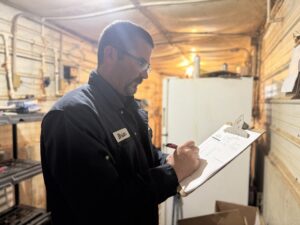Running a successful swine operation takes more than great feed, it takes hands-on management, consistent communication, and trusted support. That’s why Five Star Cooperative offers a complete line of Swine Feed Site Management Services, designed to help you maximize efficiency, animal performance, and return on investment.
Whether you manage multiple barns or operate a single site, our experienced swine specialists are here to keep your operation running smoothly from start to finish.
Pig Counting and Grading
Accurate pig counts and weight grading are essential for managing nutrition, barn flow, and marketing. Our team performs precise head counts and grading to track group progress, helping you make informed decisions throughout the feeding cycle.
Barn Control Checks
Temperature, ventilation, and humidity have a direct impact on pig health and feed efficiency. We regularly monitor and document barn conditions to ensure your environment supports animal comfort and performance — because even small adjustments can make a big difference.
Nutritional Plan Management
With a team of experienced nutritionists and feed specialists, we manage customized feed and nutritional plans tailored to your pigs’ growth stage, genetics, and production goals. We continually review feed consumption and performance data to keep your program on track.
Communication and Updates
Consistent communication is key. We serve as a direct line between caretakers, site owners, and the Five Star swine team — ensuring everyone is informed and aligned on animal health, performance, and barn status. From weekly updates to real-time alerts, you’ll always know what’s happening on-site.
Close-Outs and ROI Reporting
When groups are marketed, our team can provide comprehensive close-out summaries and return-on-investment reviews. These reports highlight feed conversion, average daily gain, and overall group performance, helping you identify opportunities for even greater efficiency next turn.
Beyond the Barn
Our commitment goes beyond data and feed. Five Star site managers monitor overall site care, ensuring biosecurity standards, cleanliness, and maintenance stay a top priority. We take pride in treating each site as if it were our own because your success is our success.
Ready to Strengthen Your Operation?
Partner with Five Star Cooperative’s Swine Feed team and gain peace of mind knowing your sites are being managed with care, precision, and expertise.







